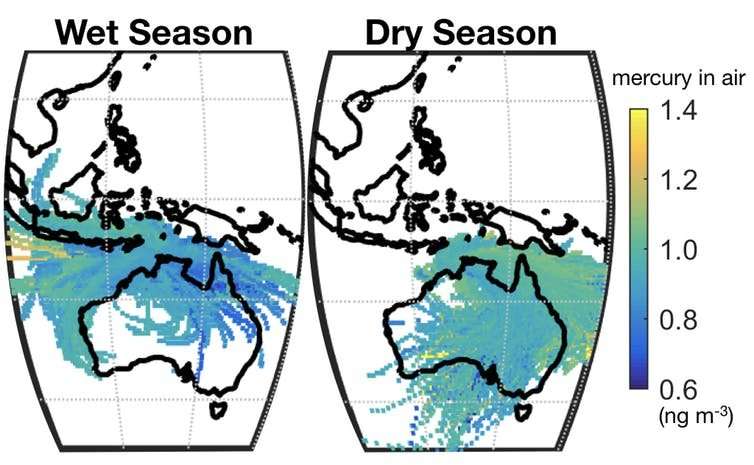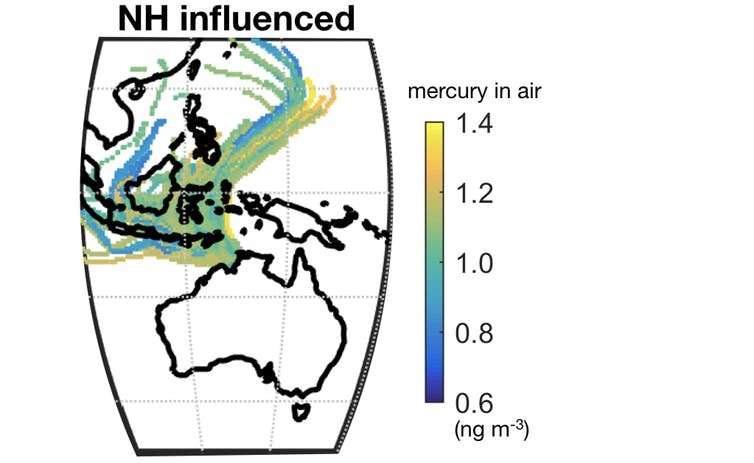Mercury from the northern hemisphere is ending up in Australia

Mercury pollution has a long legacy in the environment. Once released into the air, it can cycle between the atmosphere and ecosystems for years or even decades before ending up deep in the oceans or land.
The amount of mercury in the ocean today is about six times higher than it was before humans began to release it by mining. Even if we stopped all human mercury emissions now, ocean mercury would only decline by about half by 2100.
To address the global and long-lasting mercury problem, a new United Nations treaty called the Minamata Convention on Mercury came into effect last month. The treaty commits participating countries to limit the release of mercury and monitor the impacts on the environment. Australia signed the Convention in 2013 and is now considering ratification.
Until now, we have only been able to guess how much mercury might be in the air over tropical Australia. Our new research, published in the journal Atmospheric Chemistry and Physics, shows that there is less mercury in the Australian tropics than in the northern hemisphere – but that polluted northern hemisphere air occasionally comes to us.
A global problem
While most of mercury's health risks come from its accumulation in ocean food webs, its main entry point into the environment is through the atmosphere. Mercury in air comes from both natural sources and human activities, including mining and burning coal. One of the biggest mercury sources is small-scale gold mining – a trade that employs millions of people in developing countries but poses serious risks to human health and the environment.
Once released to the air, mercury can travel thousands of kilometres to end up in ecosystems far away from the original source.
Measuring mercury in the tropics
While the United Nations was gathering signatures for the Minamata Convention, we were busy measuring mercury at the Australian Tropical Atmospheric Research Station near Darwin. Our two years of measurements are the first in tropical Australia. They are also the only tropical mercury measurements anywhere in the Maritime Continent region covering southeast Asia, Indonesia, and northern Australia.
We found that mercury concentrations in the air above northern Australia are 30-40% lower than in the northern hemisphere. This makes sense; most of the world's population lives north of the Equator, so most human-driven emissions are there too.
More surprising is the seasonal pattern in the data. There is more mercury in the air during the dry season than the wet season.
The Australian monsoon appears to be partly responsible for the seasonal change. The amount of mercury jumps up sharply at the start of the dry season when the winds shift from blowing over the ocean to blowing over the land.
But wind direction can't explain the whole story. Mercury is likely being removed from the air by the intense rains that characterise the wet season. In other words, the lower mercury in the air during the wet season may mean more mercury is being deposited to the ocean and the land at this time of year. Unfortunately, there simply isn't enough information from Australian ecosystems to know how this impacts local plants and wildlife.
Fires also play a role. Mercury previously absorbed by grasses and trees can be released back to the atmosphere when the vegetation burns. In our data, we see occasional large mercury spikes associated with dry season fires. As we move into a bushfire season predicted to be unusually severe, we may see even more of these spikes.

Air from the north
Although mercury levels were usually low in the wet season, on a few days each year the mercury jumped up dramatically.
To figure out where these spikes were coming from, we used two different models. These models combine our understanding of atmospheric physics with real observations of wind and other meteorological parameters.
Both models point to the same source: air transported from the north.
Australia is usually shielded from northern hemispheric air by a "chemical equator" that stops air from mixing. This barrier isn't static – it moves north and south throughout the year as the position of the sun changes.
A few times a year, the chemical equator moves so far south that the top end of Australia actually falls within the atmospheric northern hemisphere. When this happens, polluted northern hemisphere air can flow directly to tropical Australia.
We observed 13 days when our measurement site near Darwin sampled more northern hemisphere air than southern hemisphere air. On each of these days, the amount of mercury in the air was much higher than on the days before or after.

Tracing the air backwards in time showed that the high-mercury air travelled over the Indonesian archipelago before arriving in Australia. We don't yet know whether that mercury came from pollution, fires, or a mix of the two.
A global solution
To effectively reduce mercury exposure in sensitive ecosystems and seafood-dependent populations around the world, aggressive global action is necessary.
The cross-boundary influences on mercury that we have observed in northern Australia highlight the need for the type of multinational collaboration that the Minamata Convention will foster.
Our new data establish a baseline for monitoring the effectiveness of new actions taken under the Minamata Convention. With the first Conference of the Parties having taken place last week, hopefully it will only be a matter of time before we begin to see the benefit.
Journal information: Atmospheric Chemistry and Physics
Provided by The Conversation
This article was originally published on The Conversation. Read the original article.![]()


















